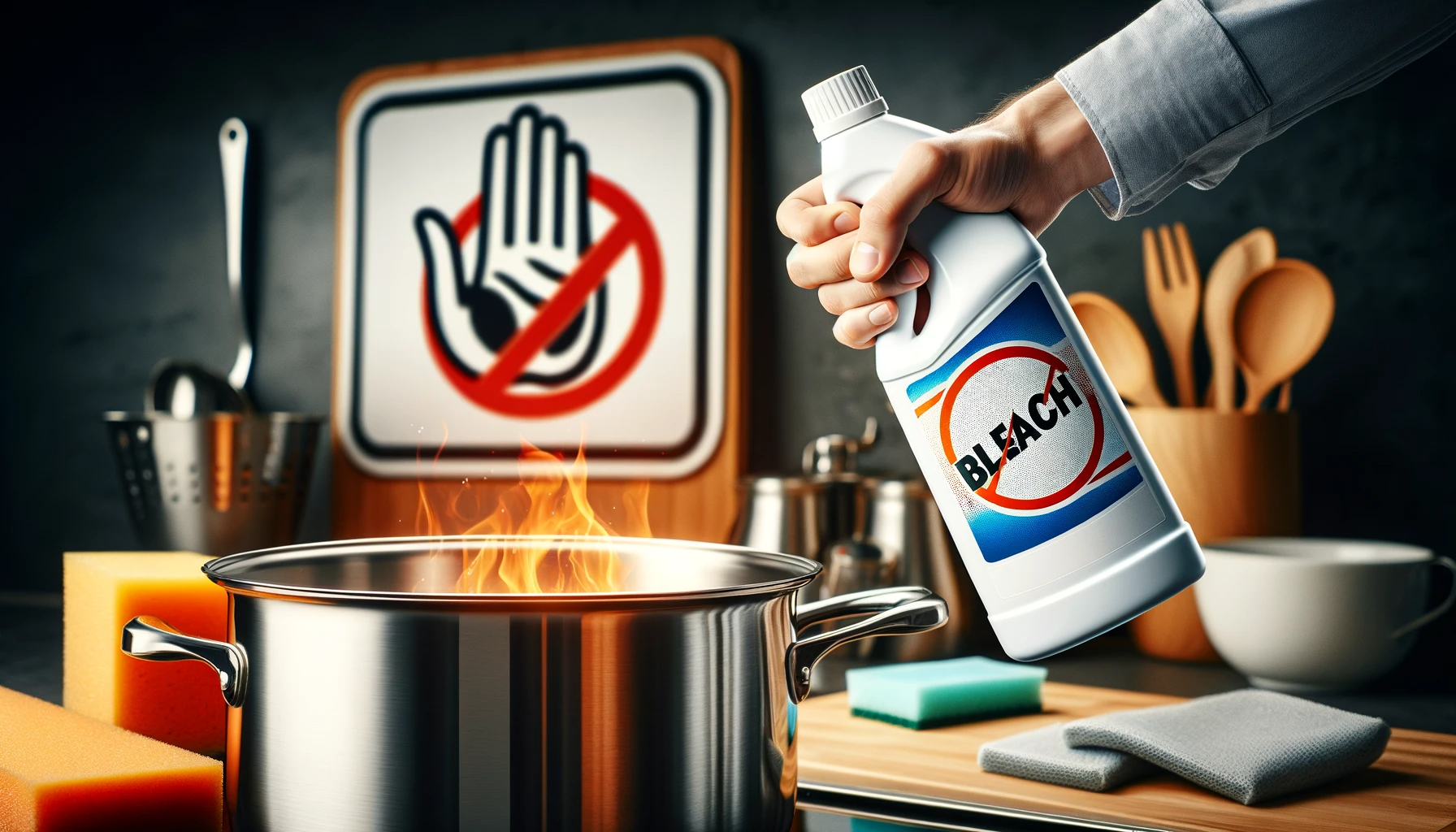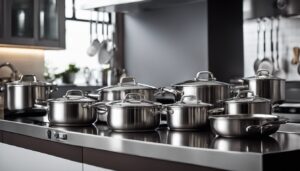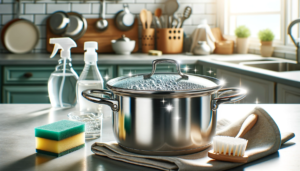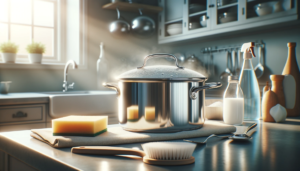Have you ever reached for the bleach to clean tough stains on your stainless steel cookware and wondered – is this safe or will it cause damage?
Using bleach to clean stainless steel pots and pans actually poses significant risks that every cook should be aware of.
Let’s explore the dangers and alternatives to bleaching stainless steel cookware.
Should You Use Bleach on Stainless Steel Cookware?
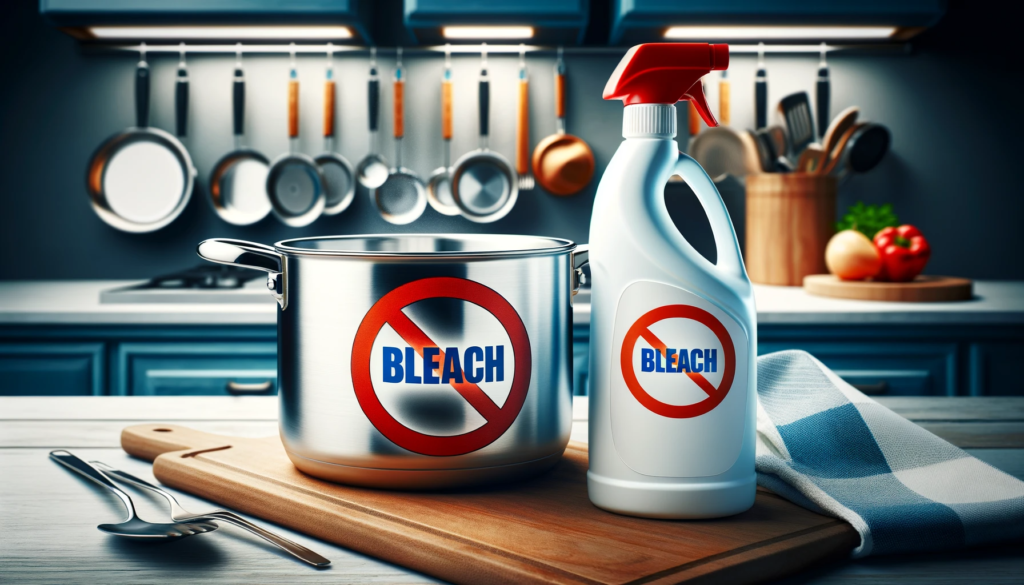
In most cases, no bleach should not be used to clean stainless steel pans, pots or other cookware.
While bleach may appear to remove some stubborn stains and residue, the potential risks and damage posed to stainless steel outweigh any minor cleaning benefits.
The chlorine in bleach breaks down the protective layer, enabling corrosion and leading to rust, pitting, and metallic tastes in your food.
Time and again, stainless steel manufacturers advise consumers to never use harsh bleaching agents.
Read on as we explore why bleach and stainless steel don’t mix and provide some safer cleaner options for your cookware.
The Dangers of Using Bleach on Stainless Steel Cookware
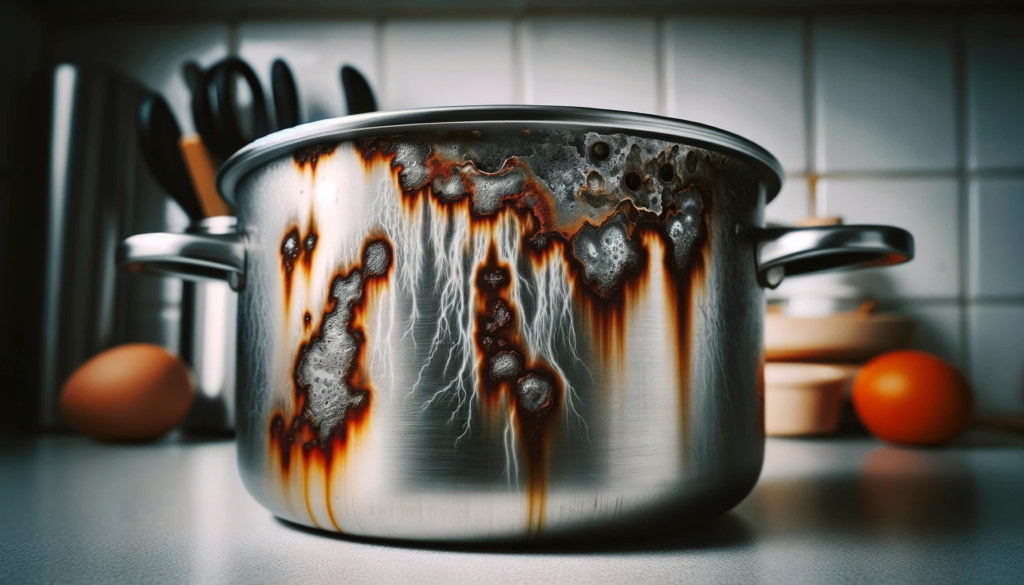
Using bleach on stainless steel cookware can damage the protective layer that helps prevent corrosion.
Stainless steel contains chromium which reacts with oxygen to form a chromium oxide layer on the surface.
This layer helps make stainless steel resistant to rusting and staining.
Bleach contains chlorine which can break down this protective barrier over time with repeated or improper use.
If the chromium oxide layer gets compromised, the stainless steel becomes much more vulnerable to damage through oxidation which shows up as discoloration, pitting, and surface rust.
Once deterioration starts, it becomes even easier for rust and corrosion to take hold in the pits and cracks.
The integrity of the cookware surface erodes to the point where the stainless steel properties are lost.
Over time, the protective later of chromium that forms on stainless steel can get damaged by bleach.
This leaves the steel much more exposed to corrosion issues like staining, pitting, and rust formation.
When the bleach deteriorates the chromium oxide layer, it essentially compromises the main barrier that makes stainless steel so rust and stain resistant.
This leads to oxidation occurring more rapidly and surface discoloration beginning to take hold.
Deterioration accelerates exponentially once pits, cracks, and imperfections form on the steel’s surface due to initial minor corrosion damage.
Rust and staining can grab hold in these compromised spots at much higher rates.
When the fundamental integrity of the cookware surface erodes from bleach exposure, the stainless steel is no longer able to resist corrosion through passivation and instead will begin failing rapidly.
Chlorine Residues Cause Food Contamination
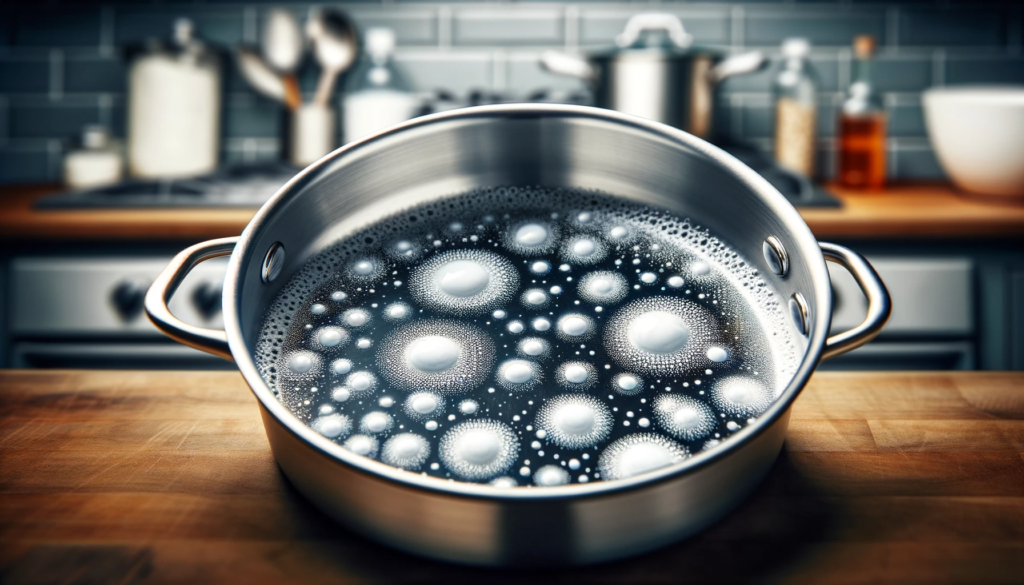
Another major risk with using bleach to clean stainless steel cookware is that chlorine residues are left behind on the interior surfaces even after rinsing.
Heating bleached pans reactivates and releases these residual chlorine compounds into food which imparts unpleasant chemical tastes and odors.
This effect has been compared to the taste of boiling water in an over-chlorinated swimming pool.
Not only are the flavors spoiled by the contaminated steam vapors, but heating volatile chlorine compounds like this can pose health risks over time.
And even in trace amounts, bleach leaves behind a stubborn metallic aftertaste that lingers persistently no matter how much you try masking it with spices, sauces or ingredients.
All in all, bleaching stainless steel cookware poses an unacceptable level of risk for food flavor and safety.
When bleach is used to clean stainless steel pots and pans, residual chlorine particles are left deposited on the interior cookware surfaces.
Even thorough rinsing does not remove all traces of chlorine residue left embedded in minute pores and textures.
Then when heat is applied to bleach-cleaned cookware, those residual chlorine particles get reactivated and released into the food.
The contamination imparted by vaporized chlorine escaping into dishes during heating spoils flavors and poses safety issues through prolonged exposure.
Many compare cooking in bleach-cleaned pots to the experience of boiling pasta or vegetables in over-chlorinated swimming pool water.
An aggressive chemical taste permeates everything.
Metallic undertones also manifest from trace chlorine reactions with steel alloys and metallurgic components.
This imparts an unnatural harshness and chemical aftertaste that lingers stubbornly no matter what seasonings or ingredients you try to mask it with.
Few things are more unappetizing than biting into a lovingly simmered sauce only to be hit with an aggressive metallic bleach flavor.
Safer Alternative Cleaners Are Readily Available

Luckily, there are much gentler yet still highly effective cleaners for stainless steel cookware available.
Baking soda mixed with water into a paste makes for an abrasive yet non-toxic scrub.
The salty alkalinity helps lifts dirt and oil residue without damaging steel surfaces when used with a soft sponge or cloth.
Baking soda also has natural deodorizing properties to remove stubborn smells left over from cooking.
Distilled white vinegar is another effective cleaning option as the acetic acid cuts through grease and also removes water spots through dissolving mineral deposits.
For tougher burnt on food residue, letting pans soak for a bit in diluted vinegar can help loosen carbonized material without abrasive scrubbing that might mar finishes.
Lemon juice works similarly for its acidic properties.
And bonus – everything will smell nice and refreshing after!
Thankfully there are plenty of effective yet gentle stain removal solutions for stainless steel that pose none of the risks of bleach.
Baking soda makes for an abrasive paste when mixed with water that lifts away grimy residue without scratching cookware surfaces when applied with a soft cloth or sponge.
The natural alkaline salts work to dissolve dirt and grease while also deodorizing lingering food smells.
White distilled vinegar mixed with water also cuts through stubborn oil and grease deposits by harnessing the dissolving power of acetic acid.
This mild acid also removes discoloring mineral deposits and water stains on contact by dissolving alkaline buildup and other inorganic material.
For especially tough burnt on carbon, letting cookware soak for a period in vinegar solution helps gently lift adhesion and loosen debris for a final wipe down.
Citrus juice like lemon and lime work through very similar acid-based cleansing mechanisms as vinegar minus the bold smell.
A benefit shared by all these homemade cleaners is they not only do an excellent job removing foul residues but leave kitchen tools smelling fresher in the process with light sentinel properties.
Bleach May Void Warranties on High-End Cookware
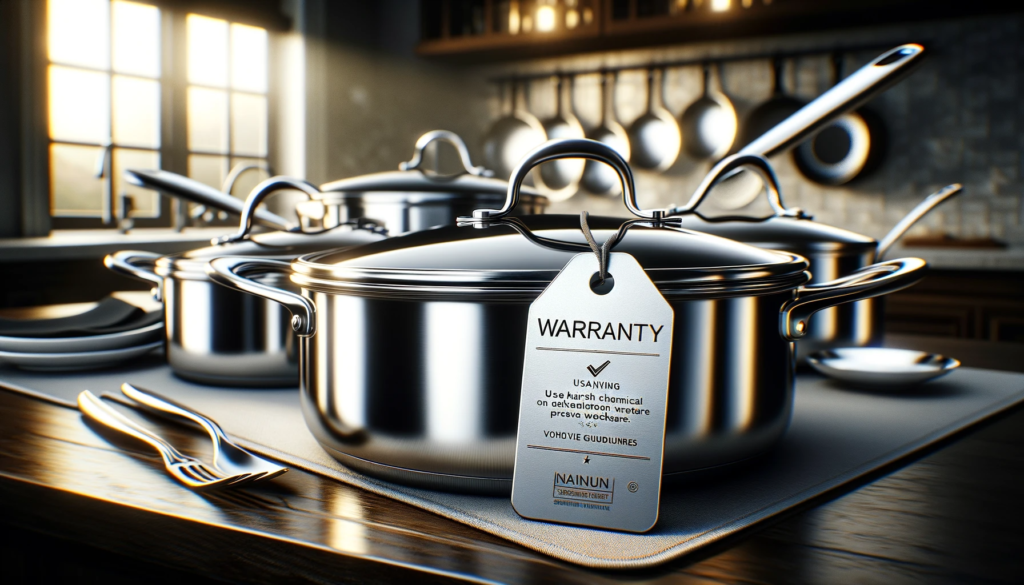
Reading carefully through manufacturer care instructions can provide guidance, but many premium cookware brands specifically warn against using bleach or other harsh chlorine cleaners.
The reason is such aggressive chemicals often lead to premature damage, corrosion, and deterioration as outlined earlier.
This kind of impaired condition stemming from bleach use has potential to void factory and seller warranties on higher end stainless steel cookware sets.
No one wants to have their expensive All-Clad or Le Creuset cookware ruined by caustic cleaning products, let alone be refused a replacement or repair job because the damage resulted from failure to heed maintenance recommendations.
For costly kitchen investments designed to last decades, its prudent to make sure proper care protocols are followed to avoid accelerated breakdowns and compromised performance.
One bleach mishap is not worth forfeiting a lifetime guarantee of sturdy construction.
While many assume harsh chemicals like bleach must clean better, instructions that come with high-end stainless steel cookware explicitly warn against using such caustic products because they often degrade materials prematurely.
This causes accelerated corrosion issues including pitting, flaking metal, deterioration, and coating erosion – not just surface stains.
By compromising integrity this way, bleach damage sustained to expensive cookware very likely voids factory and seller warranties on brands like All-Clad, Le Creuset, and other investment-grade sets.
No one wants to ruin their $500+ cookware with bleach only to discover replacement is refused because impairment resulted from improper maintenance.
So for costly kitchenware expected to last decades if cared for properly, its critical to follow manufacturer cleaning guidelines to preserve function and warranty eligibility.
One seemingly small bleach mishap that saves time initially can forfeit lifetime construction guarantees down the road.
Conclusion
Given the risks of using bleach on stainless steel cookware – degrading finishes, metallic tastes, voiding warranties, and potential chemical leaching – there is little justification for its use when gentler yet effective cleaning options are available.
Let combinations like baking soda paste or diluted vinegar solution tackle tough grime or discoloration instead.
Then if extra disinfecting is needed, a food-safe alternative like hydrogen peroxide can sanitize without compromise.
Avoiding bleach preserves the cookware’s integrity, ensuring optimal flavor, appearance and sanitation over years of use.
Even tiny residual amounts can leave metallic tastes that ruin the flavor of cooked foods.
Thankfully, there are many safer cleaning alternatives that remove stubborn residues without posing the corrosion risks of harsh chlorine bleach.
For a DIY approach, custom solutions like baking soda paste or diluted vinegar work well. And specialty cleaners offer similar cleaning power without the downsides of bleach, helping lift stuck-on grime without compromising the cookware’s integrity so it can fulfill its durable lifetime.
